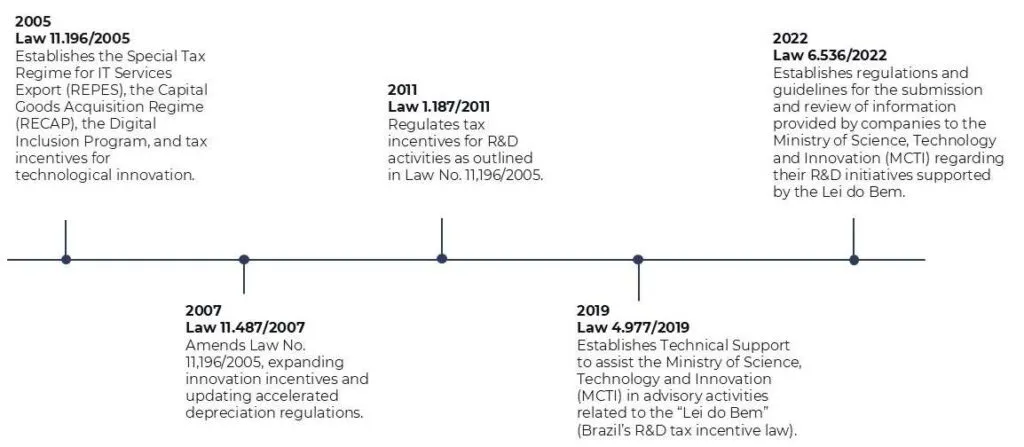In the pursuit of innovation, competitiveness, and productivity, organizations have been actively implementing cost-reduction measures while streamlining and enhancing their workflows and processes. Investment in Research and Development (R&D) is a key indicator of Brazil’s growing competitiveness—and this growth has been further supported by tax incentives.
One of the most significant of these incentives is the “Lei do Bem” (Law No. 11,196/2005), which was created to stimulate R&D and technological innovation within Brazilian companies. It allows companies to deduct certain expenses related to innovation from their Corporate Income Tax (IRPJ) and Social Contribution on Net Profit (CSLL). In simpler terms, companies investing in innovation can pay less tax—provided they meet the requirements:

Key Incentives Under Article 19 of the Lei do Bem:
- Enhanced Tax Deductions for R&D&I Expenses: Operating expenses related to Research, Development, and Innovation (R&D&I) can be deducted based on the following percentages:
- Up to 60% deduction through exclusion from the tax base;
- An additional 10% if the company increases its R&D&I team by less than 5%;
- An additional 20% if that increase is more than 5%;
- Up to 20% extra if a patent is granted or a plant variety (cultivar) is registered.
- 50% Reduction of IPI (Industrialized Products Tax):
Applies to the acquisition of equipment and goods used in R&D&I projects.
- Full Accelerated Depreciation:
New assets dedicated to R&D&I can be fully depreciated faster than usual, which helps reduce taxable income more quickly.
- Accelerated Amortization:
Intangible assets used in R&D&I—such as software or intellectual property—can also be amortized more quickly. - Zero Rate of Withholding Income Tax (IRRF):
Applies to remittances abroad related to the registration and maintenance of trademarks, patents, and cultivars.
To qualify for these incentives, companies must be taxed under the Actual Profit regime (Lucro Real) and be compliant with their tax obligations. Additionally, they must report their R&D&I activities to the Ministry of Science, Technology, and Innovation (MCTI), providing detailed documentation to support their claims.
Here’s a breakdown of the types of activities that qualify:
- Directed Basic Research:
Work aimed at deepening understanding of new phenomena, often as a first step toward innovation. This typically lays the groundwork for future applications. - Applied Research:
Research focused on gaining practical knowledge to develop or improve products, processes, or services. - Experimental Development:
Activities that apply existing knowledge to test, validate, or demonstrate the technical and functional viability of innovations.
Internal transformation: R&D and the “Lei do Bem”
The software sector is one of the biggest beneficiaries of Brazil’s “Lei do Bem” (Law No. 11,196/2005), which offers tax incentives to companies investing in Research & Development (R&D). In 2022 alone, 494 companies used the law’s benefits, resulting in R$ 714 million in tax relief. These savings were largely reinvested in technological development—especially in high-risk, high-impact projects involving artificial intelligence (AI), automation, and other emerging technologies.

While it’s true that AI and automation are often associated with software firms, these innovations aren’t limited to the tech sector. One key feature of the Lei do Bem is that it doesn’t require the innovation to be linked to the final product. Instead, any project that brings a technological advance—even if it’s internal or process-oriented—can qualify.
This opens the door for industries such as manufacturing, pulp and paper, and food and beverage to use innovative software solutions in their internal operations. Whether it’s integrating IoT systems, using machine learning for predictive maintenance, or automating supply chains, these improvements can all contribute to greater productivity and qualify for tax incentives under the Lei do Bem.
Software projects tend to be more adaptable and scalable, which makes them more straightforward to validate as innovative under the Lei do Bem. These projects often directly enhance organizational efficiency, data-driven decision-making, or automation of manual tasks—clear markers of technological improvement.
For example, imagine a factory implementing a customized energy tracking system. If the software is tailored to the company’s unique operational metrics, and helps improve performance or reduce waste, it could be considered an innovative initiative under the program.
Ultimately, the law supports a shift in how companies use software—not just as a product, but as a strategic tool for internal transformation. For organizations seeking to boost competitiveness, this represents a powerful opportunity.
Real-world applications in manufacturing
Melhoramentos Florestais, a company focused on pulp production, leveraged the tax incentives of the Lei do Bem to develop sustainable packaging made from cellulose fiber. With the support of GT Group, the company succeeded in building an innovative plant in Minas Gerais, with an initial investment of R$ 40 million. The project not only promoted sustainability, but also generated jobs and strengthened the domestic supply chain.
Klabin, a leading Brazilian producer and exporter of packaging paper and sustainable solutions, also stands out as an innovative company. The company develops proprietary software projects that qualify for the Lei do Bem, encouraging research and technological development. One of the key initiatives involves the digitalization and automation of packaging systems, developed in partnership with ST-One.
The Mechanical and Transportation sector faces constant economic, political, and technological challenges to maintain its national and international competitiveness. In this context, technological innovation plays a crucial role in the modernization and strengthening of the sector, as reflected in the ongoing adoption of the Lei do Bem’s tax incentives.
However, despite the Lei do Bem being extremely positive for organizations that aim to position themselves through Research and Development, there are still challenges to its implementation. Many companies report difficulties with the volume of required documentation, lack of clarity in the evaluation criteria, and the need to produce highly specific forms, making the process cumbersome.
There are several ways to develop an innovative project and, to overcome the challenges involved in this process, an effective alternative is to partner with specialized firms—from consulting companies to technology providers—that can support both the design and execution of projects.
Learn more about ST-One.